FAQs on African Cichlid
Identification 5
Related Articles: African Cichlids, Malawian
Cichlids: The Mbuna and their Allies By Neale Monks, The Blue
Followers: the Placidochromis of Lake Malawi by Daniella
Rizzo,
Related FAQs: African Cichlid ID 1, African Cichlid ID 2, African Cichlid ID 3, African Cichlid ID 4, & African Cichlids, African Cichlid Selection, African Cichlid Behavior, African Cichlid Compatibility, African Cichlid Systems, African Cichlid Feeding, African Cichlid Reproduction, African Cichlid Disease, Cichlids of the World, Cichlid Systems, Cichlid Identification, Cichlid Behavior, Cichlid Compatibility, Cichlid Selection, Cichlid Feeding, Cichlid Disease, Cichlid Reproduction, & Malawi Cichlid Systems, Tanganyikan Systems,
|
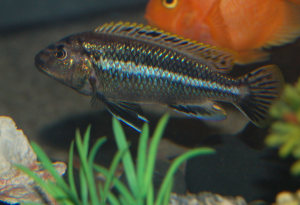
|
|
Fish in picture with electric blue Dempsey
8/18/17
Hi! I recently acquired some new fish and do not know the species. I see them
pictured on your page housed with the electric blue Dempsey and am curious as to
the species I attached a picture. Any help would be appreciated! Thank you
<Hello Michelle. Off the top of my head, nope, don't recognise this. It's got
the build of a Hemichromis, so I'm guessing something West African, but it might
well be something Central American. Similarly, while the pattern
reminded me of Tilapia buettikoffteri and/or Tilapia jokae, the oblique band
through the eye is wrong for them. Instead let me direct you to an excellent
cichlid identification forum:
http://www.cichlid-forum.com/phpBB/viewforum.php?f=14
Given there are something like 2000 cichlid species out there, few people know
them all (I certainly don't!) but a group effort like that forum should be able
to help. Good luck, and if you find out what it is, perhaps you'll let me know!
Cheers, Neale. PS. Will cc our own cichlid expert, Chuck Rambo, for his input
too.>
|
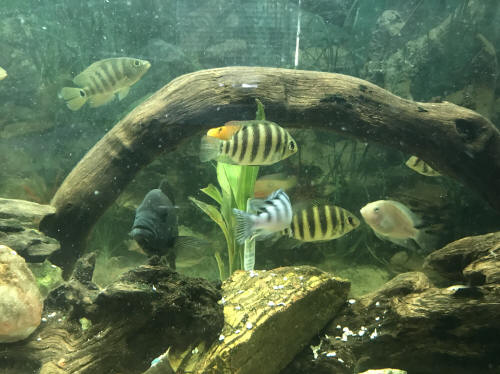
Re: Fish in picture with electric blue Dempsey
Ty!!
<W! N!>
|
|
Re: Fish in picture with electric blue Dempsey
9/15/17
Hi just thought I'd let you know that these are spotted tilapia!��
my previous excitement is now gone and I have spotted tilapia with my
African cichlids lol.
<Mmm; Pelmatolapia mariae? Do you know the species?
Tilapia/Oreochromis/Sarotherodon... are African Cichlids. Bob Fenner>
Re: Fish in picture with electric blue Dempsey /Neale
9/16/17
Hi just thought I'd let you know that these are spotted tilapia! My
previous excitement is now gone and I have spotted tilapia with my
African cichlids lol.
<It'll likely be fine. This fish used to be called Tilapia mariae, under
which name you'll see it quite often in older, more comprehensive
aquarium books such as Baensch's Aquarium Atlas. It's fairly robust in
temperament,
so not a community fish, but outside of breeding not outright psychotic.
I've kept them with large catfish (e.g., Synodontis nigrita) for example
without problems. It's a food fish though, and you should expect an
adult size of at least 20 cm/8 inches under aquarium conditions. Also,
while basically a herbivore (like most tilapia) with a need for plenty
of green foods, it can consume bite-size fish, and again like all
tilapia has a limitless appetite! Water chemistry is not a major issue,
but avoid very soft/acidic conditions, as the species is more of a
coastal freshwater, even brackish water fish than an inland, blackwater
or swamp-dwelling fish.
Cheers, Neale.>
|
|
Fw: Please help 2/21/17
Bob a request for fish ID from William James in Swaziland.
Please help 2/21/17
Hi Pete,
I am just hoping that this gets to you as I have not been able to send to
hotmail accounts, but I am hoping that the error has been fixed now.
William asks if your friend can possibly identify the attached pic of a
fish.
I hope you are keeping well, I do kinda keep up with your whereabouts on
Facebook at least.
Take care
Hope you get this
Cheers
Liz
Re: Please help 2/21/17
Yikes; a cichlid, but... Where is this from, as in what lake/area? BobF
RE: Please help 2/21/17
Hi Bob/Pete
I trust you are well my son found it in a small irrigation canal and brought
it home to put in my fish tank when I had a Closer look at it it did not
look like any Bream I had ever seen but more like a cichlid from Lake Malawi
however I thought that would be impossible to get a cichlid coming all that
way to Swaziland through a river system. I'm fascinated to try and find out
what type of fish that is. I hope you can help
kind regards
William
Fwd: Please help 2/21/17
Hello Liz and William,
Your fish looked to me like a Haplochromine cichlid of some sort, and given
its shape and size, I was thinking of the dwarf mouthbrooders of the genus
Pseudocrenilabrus. So I passed along your photos to Mary Bailey, a
well-known cichlid expert with a particular interest in the African species.
She was able to go one better than me, suggesting Pseudocrenilabrus
philander, the Southern Dwarf Mouthbrooder cichlid. Additional photos would,
I am sure, be useful.
Pseudocrenilabrus are interesting fish, small but colourful, but the males
are quite aggressive and ill-suited to the average community tank, so be
careful with whatever else is in with them!
Regards, Neale
|
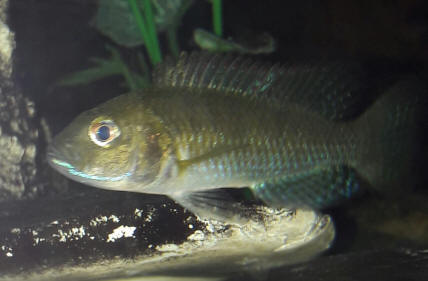 |
|
Cichlid ID 5/3/15
Good day, kind sirs.
I was wondering if you could help me with an ID.
These pics are bad (sorry).
I believe I'm dealing with Venustus or Livingstoni.
<Mmm; yes.... Nimbochromis (nee Haplochromis Boulenger 1908) venustus>
I sent my wife to the LFS for BUMBLEBEES and this is what they sold her.
I apologize if this is not your forte. Simply ignore if that is the case
:-)
Thanking you in advance...
Father of two.
P.S.
You guys helped with my 55 build about 6-9 months back. All went well,
THANKS!
<Ah, welcome. Bob Fenner>
re: Cichlid ID 5/3/15
Thank you!!!
<Welcome. BobF>
|
 |
|
Copadichromis Melas or Midnight Mlotos?
12/23/14
Copadichromis Melas Verification
Hello: I was looking for info on the Copadichromis Melas on the site.
There is a Midnight Mloto and I wonder if this "midnight mloto" is just
a marketing name. Also, is this fish hybrid or naturally found with the
black coloring. Would this color be of the male or female. I hope the
attachment is not too big, about 220KB
Thank you
< This is a real fish found in Lake Malawi and described in 2006 by Ad
Konings and Jay Stauffer out of Penn State. The photo looks like a male.
Females tend to remain silvery in color.-Chuck> |
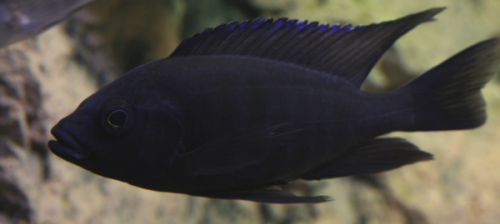 |
question about a Kenyi Cichlid
Blushing Kenyi Cichlid
8/21/14
Hello! I have a 55 gallon tank in my biology classroom, and I have
primarily kept cichlids for the past 17 years - an Oscar for 9
years and most recently a Flowerhorn for 7
years that died last November. I now
want to try a different type of cichlid, and
have been looking at the Kenyi - have been
advised to go with one male and five females, lots of plants and
caves. My local pet store has what I am looking for, but I have
one major concern. The beautiful yellow male
(about 2 inches) has a perfect red circle on
each side (about the size of a smarty candy) near the gills.
The lady at the store says she has isolated him and treated him with
antibiotics several times thinking he was sick even though he
never acted sick and always ate well. She says
she Googled it and found out it is a genetic
color mutation and that it is completely healthy. IF this is true,
it would be a cool way to teach "neutral" genetic mutations in my
classroom. I tried to Google it and can't find anything. ????
Help ????
Shannon Blanton,
< Do a Google image search for blushing angelfish. These are line bred
fish that have been selected for clear gill covers. If these patterns
look similar to the Kenyi you have seen then they may be a new strain of
Kenyi.
A case of genetic selection by breeders.-Chuck>
|
Identification of cichlids
8/6/14
Lake Malawi Cichlid ID
Could you please identify these two species for me. The one on the
bottom was orange and turned a very light orange or peach.
Thanks!
<Both of your fish are from Lake Malawi. The first photo is of a
Petrotilapia species. Either a female or a young fish. These fish get
big so if one changes colors it will be easier to identify the species.
The
second photo looks like a Labidochromis species. Maybe from Chisimulue.
Check out both of these genera on image search to try any narrow it
down.-Chuck>
Peter O'Brien
|

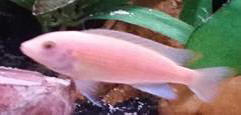 |
|
Re: Identification of cichlids
8/6/14
Thanks for the info. I was not thinking Labidochromis at all. I thought
maybe zebra.
Peter
Lake Malawi Cichlid ID II 8/7/14
< Labidochromis have a small pointed mouth to pick invertebrates from
between rocks. Metraclima/Pseudotropheus have a wide scraping mouth to graze
on algae.-Chuck>
|
|
Help Identifying a Cichlid
ID Lake Malawi Cichlid 2/27/14
I've recently purchased a cichlid and would like to know if you can tell
me what it is. I've done research and think it is a Labeotropheus
fuelleborni but am not sure. Thank you.
< Your fish is definitely a Labeotropheus. There are only two species
that have that extended nose. L. fuelleborni are big a have a fuller
body. The L. trewavasae are thinner and more streamline. Usually the
females have the pinkish body color as shown in your photos. Chuck>
|
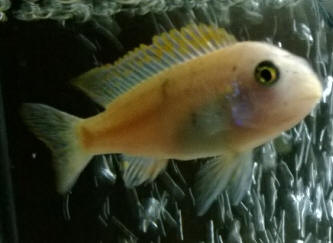
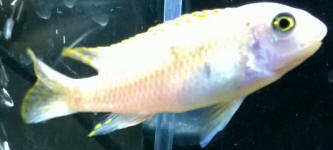 |
Fwd: Cichlid 1
11/3/13
Bob/Neale,
<Hey Rick>
Can either of you identify the cichlid in the attached photo? I paged
through my copy of Axelrod and couldn't find anything that matches well
enough for me to be confident. The pair is up for adoption, but I need
to know what they are to determine whether I can adequately house them.
<Mmm, don't know... does look Lamprologine as Neale speculates. We're
waiting on Chuck Rambo's input. B>
This is a photo of the most cooperative of the two. The other has another
black spot along the lateral line. They are currently about 3 inches
long.
Behavior I observed is that they stick pretty close to the little rock
decoration you see in the picture, so I'm guessing they are some kind of
Malawians. They would have to go in with my J. dickfeldi if I were to
take them. |
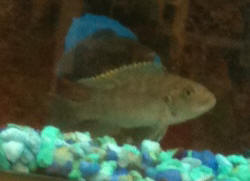 |
|
African Cichlid ID 11/3/13
Can either of you identify the cichlid in the attached photo? I
paged through my copy of Axelrod and couldn't find anything that matches
well enough for me to be confident. The pair is up for adoption,
but I need to know what they are to determine whether I can adequately
house them.
This is a photo of the most cooperative of the two. The other has
another black spot along the lateral line. They are currently
about 3 inches long.
Behavior I observed is that they stick pretty close to the little rock
decoration you see in the picture, so I'm guessing they are some kind of
Malawians. They would have to go in with my J. dickfeldi if I were
to take
them.
< Hard to tell from the photo exactly the species is in the photo. It
does look like some kind of Malawian Mbuna but is probably a cross. They
would be too aggressive to place with your J. dickfeldi. These Mbuna
have teeth used to scrape algae off of rocks and can be very destructive
on fins and scales.-Chuck>
|
|
Cichlid questions
4/28/13
Hi WWM Crew,
Hope all is well. I've recently inherited a 55 gallon Mbuna tank from my
brother-in-law - with twins on the way my sister decided it was time to
start cutting back on some things. Unfortunately my brother-in-law's
knowledge of the fish seemed to end with "they looked nice." I've tried
to do some research online, but found a couple points I could use
clarification on. From what I can tell, the current species in the tank
are 5 Demasoni,
<Males of this species are extremely aggressive, particularly towards
their own species and other fish with similar colours. Multiple females
per male will help, as will masses of rockwork, but your aquarium is at
the absolute minimum size for this species. Don't be fooled by its small
adult size (around 7-8 cm) being half that of regular Mbuna -- in no
sense is this a "dwarf" cichlid in terms of personality!>
5 Yellow Lab, 4 Snow White Socolofi, 4 Acei,
<These three are relatively easy-going species often recommended to
beginners because they're unlikely to kill one another / anything else
kept with them. They're also sufficiently different in looks that the
Demasoni should be able to tell they're not their own kind.>
and 3 upside-down cats (Synodontis Nigriventris, I believe).
<These prefer soft to moderately hard, slightly acidic to slightly basic
water chemistry. Not really suited to a hard water Mbuna system.>
All of the fish are about 2-2.5 inches in size currently.
<Still pups!>
The tank is currently showing no ammonia, no nitrites, and minimal
nitrates (i.e., at the very lower threshold of detection on my kit).
Filtration is provided by a Penguin Bio-Wheel (200 GPH) that my
brother-in-law had and a spare Fluval 305 (260 GPH) I had available and
seeded with some of the material from my tropical tank in hopes of
jump-starting its bacteria. With 460 GPH of flow I'm pretty comfortable
with the filtration. Now, on to the questions:
1) In general, anything to watch out for with that mix of species? I'd
imagine hybridization could be a problem, along with aggression (though
I haven't noticed much yet, possibly to do the tank being moved and
rearranged).
<See above.>
2) I've read that Synodontis cats in general do well with Mbunas,
however, I've also seen in a place or two that Synodontis Nigriventris
may be an exception since it prefers different water chemistry. Should I
consider relocating them to my 30 gallon tropical community tank? Or
should I just assume that since they seem to be doing well that they can
stay?
<I'd move them rather than leave them where they are. Synodontis
nigriventris is a lovely, peaceful species that does better in quiet
communities of small to medium sized fish. It's only flaws are that it's
shy (solved by keeping in groups and using floating plants, in which
case it rests under those, even in full view) and that it occasionally
nibbles at the fins of things like fancy Guppies.>
3) I've also read a fair bit about overstocking to control aggression
but haven't seen much about how many fish that actually entails. I did
see Mary's rule of thumb formula that would yield about 25 fish in a 50,
which seems like a lot to me - though since we're talking about
overstocking that well may be the point. Any guidance on that point?
<It's really tricky to define "overstocking" because it's a recipe for
disaster if not done right! The aim isn't so much to overstock the tank
as such, but to add so many of a given species that it's impossible for
any one male to set up a permanent territory. Oddly, if they're
frustrated in this, their aggression actually diminishes a bit,
presumably because evolution has favoured males that are most aggressive
when they have something worth fighting for, not merely randomly
aggressive. Anyway, if this was me, I'd remove all of the Demasoni or at
least all but one male and 2-3 females; conventional wisdom is that you
need something like a dozen Mbuna of any one species in an aquarium to
"overstock" it, and your tank just isn't the right size for that. This
is the species you need to watch, and overstocking in terms of Demasoni
will make overstocking (in the negative sense) this relatively small
tank rather easy, so you end up with difficult to manage water
parameters. The other, relatively mellow Mbuna should be happy amongst
themselves.>
4) As a follow-up to #3, if I should get more, any suggestions for what
would work well? Simply add more of the same, maybe bringing them up to
6 of each species? Or are there any other species that would fit in
nicely?
<Iodotropheus is a classic "peaceful" Mbuna, so any of those would be
worth considering; Iodotropheus sprengerae is the species commonly
offered. But yes, you might choose to add a few more of what you have
already, but do bear in mind the Socolofi will get fairly big, around 15
cm/6 inches, so your tank is already quite well stocked. You have
excellent water quality now… why push it? Many, if not most problems
with cichlid health come down to water quality, particularly chronically
high nitrate levels.>
Many thanks in advance, I've learned more from your wonderful site over
the years than I would have thought possible when I started in the
hobby.
Chris
<Thanks for the kind words. Cheers, Neale.>
Cichlid ID 4/28/13
Hello Chuck, Bob:
There's a mystery cichlid photo I've put into Chuck's pigeonhole. I'm
not very good at identifying Rift Valley cichlids on sight, though this
little Mbuna does look rather familiar. Any thoughts?
Cheers, Neale
Re Cichlid ID
4/28/13
Got me. Chuck? B
Cichlid questions
4/28/13
<Chris, I passed your question and my answer along to Mary Bailey, and
she offered up a couple alternative (and likely better) bits of advice
for you to think upon:
"I'm with you most of the way on what you say, except:
(1)Ps. demasoni is one of those species that behaves like Attila the Hun
for some people and is a pussycat for others. I would prefer a
suck it and see approach, especially as these are young fishes growing
on together and that often produces a less trauma-ridden scenario than
communities of adult Mbuna suddenly thrown into one another's company.
(2) My overcrowding strategy isn't based on large numbers of individuals
of species but on total number of Mbuna of all species. Back when
the strategy was evolved you were lucky if you could obtain a pair of a
species, let alone a bunch of them, as we were dealing with wild fishes.
You are in fact more likely to have trouble if you have multiple
conspecific males than if you have just one male of a species, because
serious fights are more likely where there is intraspecific competition.
The general idea of the crowding is not so much to stop males fighting
(heterospecific males don't usually bother) as to stop males pursuing
their females to death - the tank is so busy that the females can lose
themselves in the crowd and males are less keen on leaving their little
patch as they may come back to find it usurped and will have to run the
gamut of other males to do any serious chasing."
Hope these additions are useful. Mary knows her stuff. Cheers, Neale.>
Re: Cichlid questions
4/28/13
I feel foolish now because I completely forgot the other question I had.
I neglected to mention there are several that I have been able to
positively identify. Could you take a look and let me know what you
think they are?
I've found a couple of pictures online that look close in one way or
another so I'm starting to think they may be some kind of hybrid or
species that might not be that common in the trade.
Many thanks again
Chris
<Got this from the illustrious Ad Konings, via the ever helpful Mary
Bailey: "Almost certainly juvenile of Nimbochromis fuscotaeniatus". So
there you go! Nice fish, and Nimbochromis tend to be peaceful, though
predatory. Cheers, Neale.>
|
.JPG)
.JPG) |
|
Re: cichlid ID 4/29/13
> Hi Bob, Neale, Never got the photo. After checking the FAQ's I
guess the person figured it out. But still never saw the photo on the
FAQ's page. Chuck
> <Thank you Chuck. B>
Re: cichlid ID 4/29/13
Hmm… no… got a reply from Ad Konings via Mary Bailey, so took the
message out of your (Chuck's) folder.
Cheers, Neale
<Yes. B>
Re: Cichlid questions 4/29/13
Many thanks Neale, Mary, and all the rest for the advice and
identification - you've done a lot to put my mind at ease that I don't
have an imminent war in the tank :). I think I'm going to just leave
well enough alone with the exception of getting the cats out of there
and into a new tank. Since my tropical tank has an ever growing number
of guppies in it it'll be just the excuse I need to set up an all
catfish tank (Corys, upside-downs, and Ancistrus I'm thinking).
<Do note my warning re: S. nigriventris and fancy Guppies…>
I've fallen in love with the cichlids - I think I've spent almost as
much time watching them this weekend as my cat has - so I'm very glad to
hear that things should work pretty well as they are.
Thank you again for the help in responding to my questions and for
having such a wonderful resource available.
Chris
<Most welcome, Neale.>
|
|
Peacock Identity
Peacock Cichlid ? ID - 1/25/13
HI! Sooo, the more I LOOK at this guy, I am seeing either a MIX or some
"Hap"? Just doesn't quite LOOK like my other peacocks, but I could
be wrong. The horizontal line is throwing me.
Any thoughts? Carrie :)
< Peacock cichlids are characterized by a series of pits or pores around
the jaw and head area. These pores are used as sensors that pick up the
vibrations of prey items living in the sand. Based on the photo provided
it does not appear to be any known peacock cichlid that is found in the
wild. It is probably a cross of some sort but hard to tell with not much
color on the fish.-Chuck>
´¯`·.. ><((((º>`·.¸¸.·><((((º>´¯`·.¸.·<((((º>
><((((º>`·.¸¸.·´¯`><((((º>·
¯`·...¸><((((º>>
|
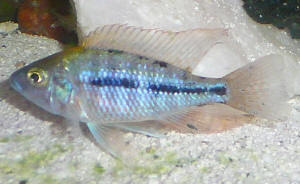 |
|
fish id, possibly Krib? 7/6/12
Bob and Crew,
I have searched your site and some others and cannot get an ID on this
animal that I am comfortable with. Based on what I see on your site, I am
thinking a Cichlid; perhaps, a Krib? He came with 6 'rescued' Blood Parrots
and is not the friendliest to them.
Thanks, as always, for your help!
Regards,
Kevin
<Nope, not a Krib. It's a Melanochromis species of some sort, probably a
male Melanochromis auratus. This species is notoriously aggressive (some
would say psychotic) but will work well in mixed species tanks if kept
alongside other very aggressive Mbuna. Like other Mbuna, it feeds primarily
on algae, so any algae-based flake food will maintain it well. Occasional
live daphnia and the like will be appreciated, too. In terms of water
chemistry, it will need moderately hard to hard, basic conditions to do
well. Cheers, Neale.>
|
 |
|
|

